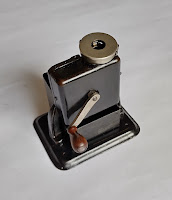Most of the parts in the plastic bags have been cleaned, so re-assembly can start. The Corona 3 folding typewriter is a reasonably straightforward machine with relatively few parts. Its construction is however a bit different from most other portable typewriters. It is however similar to most others typewriters in that it has a couple of little 'tricks'. The type of thing you'll know how to do the second time round.
One such trick was that the connecting bar at the lower-rear is not symmetrical. That's the round bar that holds the shift-adjustment screws. It only differs by a mm, but it has a left and a right end.
The keyboard is different from most typewriters, in that the key-levers form a sort of 3-row crochet pattern. The 28 key-levers all have an integrated 2-hole bracket that will hold them upright on their pivot-rod.
They keys all are clearly marked where they have to go (of course), so easiest is to set them out in the correct order - for then sliding in of the rods.
When the rods are fitted through all the key-levers and spacers etc again fitted, then the whole assemblage can be inserted into the frame from the front.
First however; also add the space-bar linkage to this assemblage! The spacebar linkage cannot be inserted into the machine after the keys-levers are fitted (and the main carriage pivot-rod is already in-place).
When the keyboard is mounted the second time (now with the spacebar), the segment can be clamped to the back-wall with the type-bar-rest brackets.
This is another quirk of the Corona; the segment is not pinned to the frame, but clamped by the brackets. It has a lot of leeway on how it is positioned in the frame, and no easy adjustment screws; loosen the bracket-screws and it all drops down again. (Adjusting will be interesting.)
For fitting the type-bars, the type-bar-rest had to be removed again. Even with the rest removed, it is 'fiddly'.
The type-bars could perhaps be fitted in the segment before mounting that in the machine. Or perhaps even onto the rod that then goes into the segment from the front (it is a slot, not a 'channel'). But then hooking-in of the connecting rods would be impossible to do.
That the universal-bar bracket has a special cut-out to allow the pivot-rod to pass through as it is fed into the segment is probably a hint that it actually was meant to be assembled this way.
So; progress and already many bags empty :)























